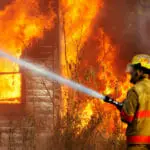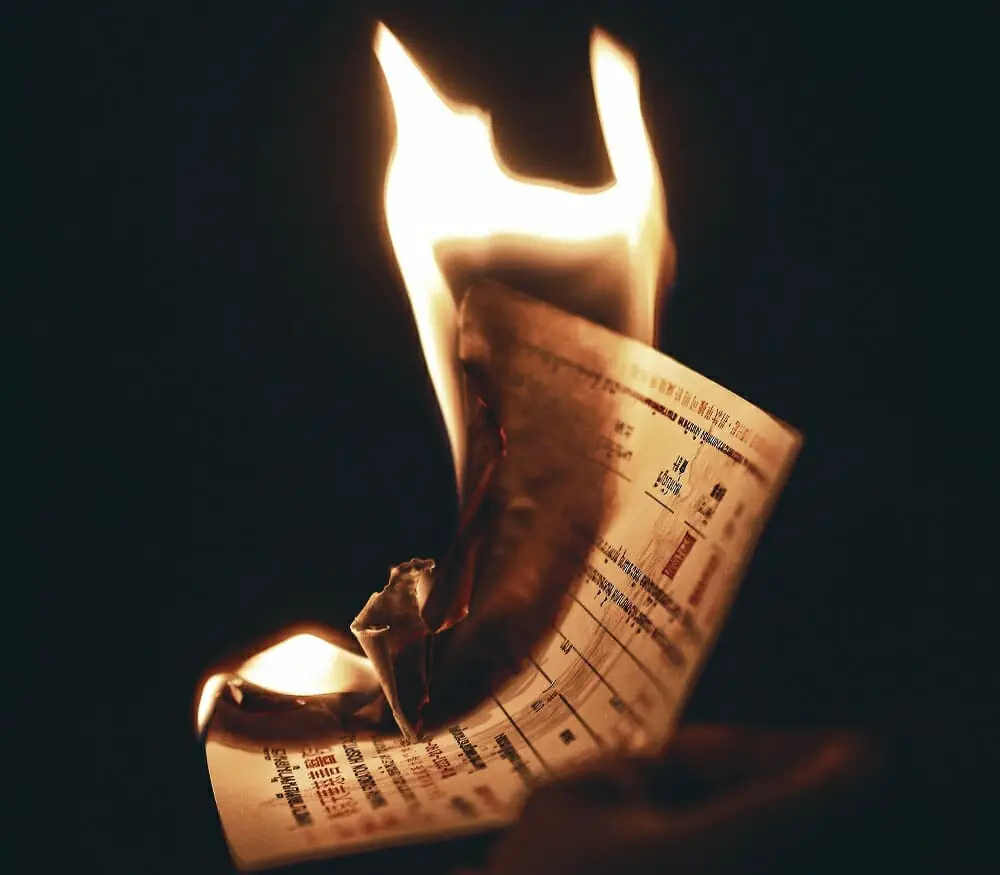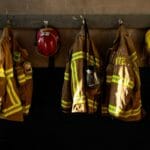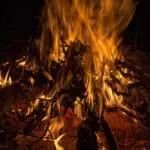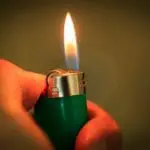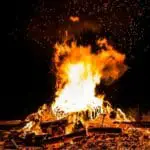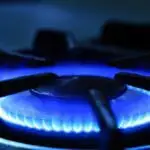From a very young age, we’re taught that fire is hot and should be treated with a lot of caution. As obvious as it might seem, fire is always dangerous and will almost always be hot enough to do damage to a person’s skin.
However, if you’re reading this article, you’ve probably wondered what the actual temperature of fire is and how hot it can get.
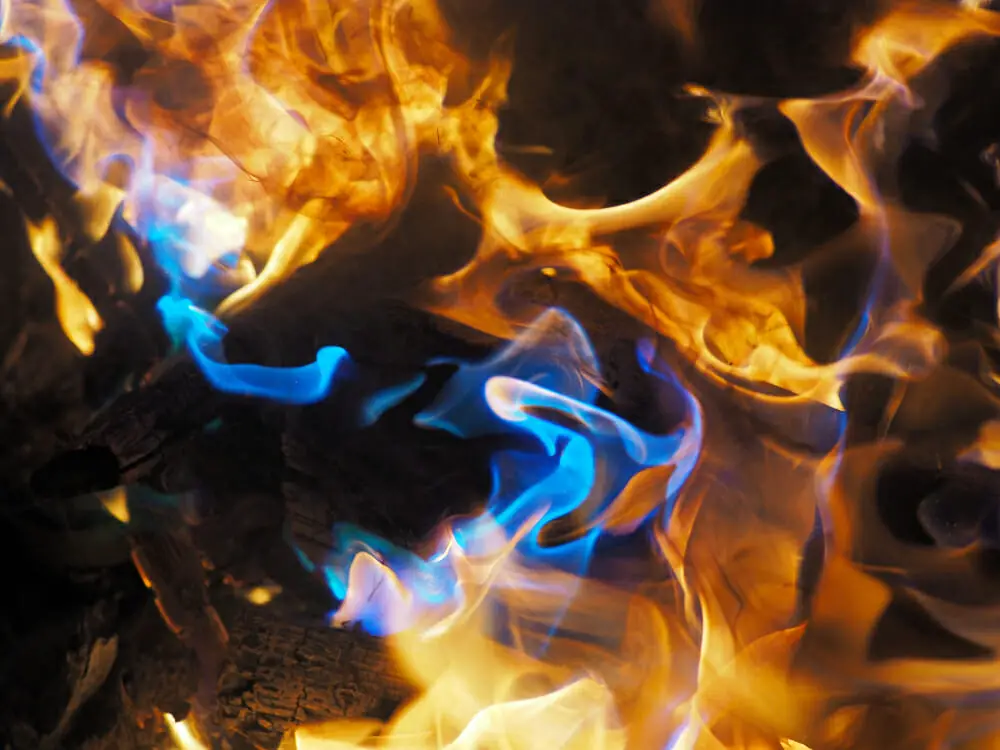
Fire from a lit match will often be around 1,100°F but there will still be slightly different temperatures around different parts of the flame.
It’s also worth noting that different materials can produce different types of flame and, therefore, different temperatures.
In this guide, we’ll be explaining everything you need to know about fire, how different materials can affect it and how hot it can possibly get.
What Is Fire?
Before we find out how hot different fires can get, let’s first take a look at what fire is and how it works. Don’t worry, we won’t be getting too scientific!
Fire is a simple chemical reaction that takes place between three different things: fuel, oxygen and heat. These three elements are known as the fire triangle and flames can not be created if even one of them isn't present.
Let’s look at the example of a simple match and find out how it uses the fire triangle to produce a flame:
- Fuel - This is the matchstick itself. The wood itself on the stem and the chemically formed head of the match are what provide fuel for the fire to burn.
- Oxygen - Quite simply, the air around the match is what provides it with enough oxygen to burn. Whilst you probably won’t find yourself in this situation, it would be impossible to light a match in space, as there would be no oxygen.
- Heat - Heat is generated when you strike the match against the side of the box. This motion creates friction, which provides enough heat for the head of the match to burst into flame.
Of course, the fuel and heat source can be different under different circumstances. However, these three principles will always remain the same when it comes to creating fire.
Once a flame has been produced (this is known as the ignition process), it will often continue to burn on its own, using the fuel source as it does so. The fire will then produce its own heat and can be used to transfer heat to other things, such as a stove or a cigarette.
Different Types Of Flame
As we said before, the source material used to create fire will have an impact on the size and color of the flame. In this section, we’ll take a closer look at these properties and how they affect the temperature of a fire.
Size
Quite simply, the size of a flame will not affect how hot a fire will burn. As long as the source materials are the same, a fire will reach the same temperature when it is a few inches tall as it will when it fills an entire room.
One thing that size does affect is how well a fire can transfer heat to other fuel sources. For example, a house fire often begins as a single, small flame from a stovetop in a kitchen.
However, the flame grows bigger when it comes into contact with other materials in the kitchen, such as food and furniture. This increases its size and allows it to spread further and grow bigger.
Color
On the other hand, the color of a flame does actually indicate how hot it might be. The best way to think about it is; the hotter a flame is, the lighter its color will be.
For example, a dark red or orange flame will often be around 1,000°F-1,500°F. Alternatively, the brightest white flame will usually be as hot as 2,300°F-2,700°F.
It should be noted, though, that the hottest flames of all are usually a blue color. This might seem a bit counterintuitive because blue is a color we often associate with cold.
However, if you’ve ever used a bunsen burner in a science class at school, you will probably have been taught to heat things on a blue flame because it’s the hottest.
A common, and pretty fun, experiment often done in high school science lessons is burning certain chemicals to produce a different colored flame. Below, is a list of the commonly used chemicals for this type of experiment:
- Potassium chloride - Purple
- Copper oxide - Blue
- Copper sulfate - Green
- Copper chloride - Light green
- Lithium chloride - Red
- Magnesium sulfate - White
In these cases, the chemical is used up as a source material for the fire pretty quickly. This means that the flame will only remain that color for a few seconds if only a gram or two of the chemical is used.
What’s The Hottest Part Of Fire?
You may already know that different parts of flame are hotter than others. Of course, with something like a barbecue or a log fire, temperatures will vary depending on how much fuel and space for oxygen there is at different parts of the fire.
However, when we talk about a single, solitary flame, from something like a match, the hottest part is always the base.
This is the part of the flame that is closest to the source material and, because it’s the hottest part, it will burn with a brighter (potentially blue) color than the rest of the flame.
As you move out away from the source material, the flame will be less hot and will therefore have a slightly darker color around the edges.
Temperatures of different types of flame
Now, let’s take a look at some of the different source materials that can be used to create fire and find out how hot each of them can get:
Candles
These are quite easy to determine the temperature of, because they only produce a single, isolated flame around a fixed point. Candles use a wick to hold the flame centrally, in one place.
However, the wax surrounding it actually acts as the fuel source for the flame. With certain candles, as the wax melts, it will produce a pleasant aroma throughout a room.
The hottest part of a candle can get up to around 2,500°F at the base of the flame, while the outer edges will be around 1,800°F.
Log Fires
A log fire in a home can create the perfect cozy atmosphere on a cold winter evening. People will often use some kind of fossil fuel based fire lighter to get the flames going but it’s the kindling and larger logs of wood that provide the fuel for the fire to keep burning.
Surprisingly, a log fire will actually burn colder than a candle, at around 1,100°F. However, log fires will often be inconsistent in temperature across the entirety of the flames.
Bonfires
Similar to a log fire that you might assemble in a fireplace in your home, with bonfires we’ll look at different source materials. They will mostly use wood, which brings fire to the same temperature as an indoor log fire.
However, some bonfires will also use charcoal and other fuels to make the flames hotter.
A bonfire will burn at around 2,000°F. That’s definitely hot enough to roast a marshmallow!
Bunsen Burners
We’ve already looked at bunsen burners a little in this article. Most bunsen burners will use a natural gas like methane to provide fuel for the flame. The gas is supplied at the bottom of the burner’s ‘chimney’ and ignited nearer the top, producing a thin, controlled cone of flame.
The hottest part of a bunsen burner’s flame is just above the tip of the primary flame. It will reach around 2,700°F at its peak.
Propane Torches
As you might have guessed, the fuel source for these implements is propane. Propane torches are used in construction and will often be employed to solder pipes together.
The reason they are so useful is because they are able to create a controlled, but very powerful flame that can transfer heat effectively to a desired material, such as copper.
The temperature of a flame produced by a propane torch is around 3,400°F, making it one of the hottest flames we’ve looked at!
What Is The Highest Temperature Fire Can Possibly Reach?
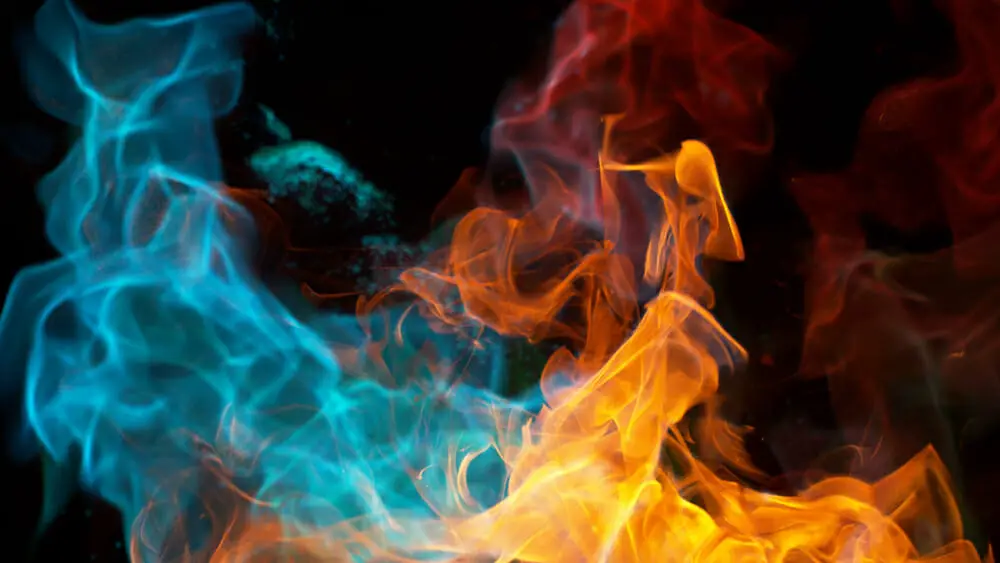
Reading through this article, this is a question that’s probably come across your mind at some point. The hottest flame we’ve discussed so far is produced by burning propane and can reach temperatures as high as 5,100°F when burned in pure oxygen.
However, there are other source materials and conditions that can produce an even hotter flame.
The hottest flame you’ll encounter under normal, everyday conditions is produced by an oxyacetylene torch, which can reach temperatures of around 5,400°F. Similar to a propane torch, these are used for welding and cutting metals.
These are tasks that require incredibly high temperatures from flames that can be used safely, in a controlled manner.
However, this is not the hottest possible flame. That title belongs to acetylene which, when burned in pure oxygen, can reach over 6,100°F! This is the highest possible temperature that can be reached by burning fuel and producing a flame.
It’s hot enough to melt tungsten, which is the element with the highest melting point in the world.
What Is The Lowest Temperature Fire Can Possibly Reach?
Interestingly, there is such a thing as cool fire, or cool flame. It’s a very rarely occurring phenomenon and it produces very little heat, light or carbon dioxide as a by-product.
However, cool fire is responsible for something called ‘engine knock’, which is that annoying noise you hear sometimes when your car doesn’t start properly.
The temperature of a cool flame is no greater than 752°F, but flames as low as 400°F have been recorded under certain conditions.
Is Fire The Hottest Thing In The World?
Unsurprisingly, fire is not the hottest substance in the world, even at its highest possible temperature of around 6,100°F.
Of course, one of the hottest things in our solar system is the sun, which can reach around 10,000°F on its surface. However, this is like a cool breeze compared to the temperature of the sun’s core, which is roughly 27,000,000 °F. That’s right, 27 million!
What’s even crazier is that higher temperatures than that have been recorded on earth. The famous experiment done with the large hadron collider at CERN produced the highest recorded temperature ever.
It reached 9.9 trillion°F, which is so hot we can’t even fathom it as human beings. To put it into some context, this man-made lab experiment produced a temperature around 366,000 times higher than the sun’s core.
How Hot Is A Forest Fire?
Forest fires can reach different temperatures at different points of the fire. On the surface of the forest floor, temperatures will reach around 1,500°F, whereas the temperature in the center of the fire could be over 2,000°F.
How Hot Is Smoke From A Fire?
You’re probably aware that one of the by-products of fire is smoke. Smoke is what happens when incomplete combustion occurs, meaning not everything is burning completely.
The smoke you see from a fire is, therefore, tiny particles of unburned material, all collecting together to appear as one mass, and this is what we can see emitting from a fire.
This is why you won’t see smoke from something like a charcoal fire, where there are just embers. In this environment, there is not enough oxygen to produce flames, so only heat is produced.
Smoke from a wood fire will be around 300°F, but will quickly drop in temperature once in the air. While smoke does have a temperature, its heat isn’t nearly as dangerous as the fire next to it. The main threat that smoke poses is to your lungs and throat if you breathe it in.
Practical Applications Of Fire
We’ve discussed a little about how some of the hottest flames are used in practical applications. Flames with a relatively low heat, such as those produced by a match, are often used for small-scale household appliances such as stoves.
However, what’s a little more technical is the way fire is used for engineering purposes. The main uses of things like propane torches is to weld together and cut apart different metals which are too strong to use normal tools for.
These metals often have a very high melting point, which means that an incredibly hot flame is needed to be able to manipulate them in a desired way.
These are some of the most commonly used metals in engineering and construction, and their melting points:
- Stainless steel - 2,750°F
- Cast iron - 2,190°F
- Copper - 1,980°F
- Aluminum - 1,220°F
As we mentioned earlier, propane torches can reach temperatures of around 3,400°F, which makes them more than capable of melting, welding and cutting any of these metals.
However, in some cases, an even stronger metal may need to be used, which could have an even higher melting point. For jobs like that, something like an oxyacetylene torch might need to be used instead.
How To Put Out A Fire
Firefighters go through rigorous training to learn all the best techniques for extinguishing a fire because there are different methods for different types of fire.
The main principle for extinguishing fires is that you need to remove at least one of the components of the fire triangle from it. This means finding a way to get rid of, or separate, fuel, oxygen or heat from a fire.
Spraying water over a fire helps to remove two of these elements: heat and oxygen. Using cold water helps to reduce the heat of the fire and bring it back down to a temperature at which it won’t burn.
However, more importantly, water also suffocates the fire, restricting the amount of oxygen that can get to it and allow it to keep burning.
It should be common knowledge that you can’t use water to extinguish every type of fire. For example, a grease or oil fire should never have water thrown at it.
The water and oil don’t mix, meaning the liquids will just splash around and spread the fire further around the room. Special types of fire extinguishers known as wet chemical fire extinguishers (or class F) use chemicals that will not cause this dangerous splashing to occur.
In general, fire extinguishers work the same way as water: by removing heat and oxygen from the fire. The only reason we use fire extinguishers instead of buckets of water in public places is because the chemicals that extinguishers use are more effective.
Other ways to remove oxygen from a fire include using a cloth, blanket or anything that will cover the flame and not allow it to suck in any more oxygen from the air around it.
Of course, it is better to do this with a non-flammable or damp material so that it doesn’t end up providing more fuel for the fire.
The other main method of extinguishing fires is to remove the fuel source. A good example of this is the great fire of London in 1666.
As the great fire moved quickly through the city of London, destroying every building in its path, it is believed that soldiers would demolish houses around the perimeter of the fire to get rid of its fuel source.
Whilst this is obviously an extreme example, it does demonstrate how removing this component of the fire triangle can help to extinguish a flame.
Of course, your local fire department will be the best people to help you extinguish a fire and, if things get out of hand, they should always be the fire people you call.
Conclusion
This has been our guide to the temperature of fire and all the things that can affect it. As we’ve found out here, there is no single answer to the question ‘how hot is fire’, because it entirely depends on the conditions that the fire exists in.
Now that you know more about how fire works, you can probably understand just how dangerous it can be. When using fire in a controlled manner, you should always show it respect and treat it with great caution.
If things get out of hand and you don’t think you can safely extinguish a flame yourself, you should always call your local fire department and make sure everyone around you is safe.

